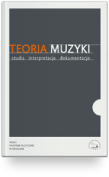Structure and Expression. Logos and
Ethos. On Polish and Lithuanian Music
Before and After 1989. A Few Reflections
Structure and Expression. Logos and
Ethos. On Polish and Lithuanian Music
Before and After 1989. A Few Reflections
Author(s): Małgorzata Janicka-SłyszSubject(s): Music, History of Art
Published by: Akademia Muzyczna w Krakowie im. Krzysztofa Pendereckiego
Keywords: Logos; Ethos; music;
Summary/Abstract: Polish and Lithuanian music of the second half of the 20th century was involved, in a particular way, in its organic historical and political contexts. The composers’ attitudes became an expression of emphasising artistic independence, e.g. Henryk Mikołaj Górecki or Feliksas Bajoras, courage to be oneself and freedom, which cannot be restricted or determined by aesthetic, or worse, ethical imperatives imposed from above, e.g. Krzysztof Penderecki or Bronius Kutavičius. Polish and Lithuanian composers – before and after 1989 – were deeply convinced that the essence of music does not lie in form and pitch constellations, or in providing the listener with superficial sensual pleasure. It lies in the meanings and senses that go beyond the world of sounds: emotional or symbolic, e.g. Anna Zawadzka-Gołosz or Onutė Narbutaitė. In aesthetic views, we had to do with a return to the thesis on the heteronomical, expressive- symbolic or semiotic nature of sounds. It was suggested that romantic emotionalism should be renewed, and the value of feeling and the subjectivity of composer and listener should be accentuated – in a new perspective, not a speculative-intellectualistic one, typical for the post-serialist avant-garde, but in the spirit of personalism. The phenomenon of strictly designing the structure of a musical work based on a system and numerical premises can be observed on two representative examples: Witold Lutosławski and Osvaldas Balakauskas. They were perceived as composers who created systems of higher order, saving in the music the organising power of the logos. It should be noted that in both cases the logically assumed structure serves expression.
Journal: Teoria Muzyki. Studia, Interpretacje, Dokumentacje
- Issue Year: X/2021
- Issue No: 18/19
- Page Range: 13-36
- Page Count: 24
- Language: English

